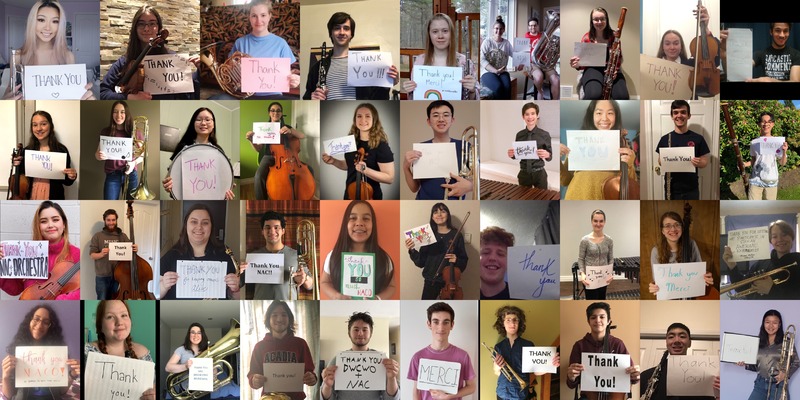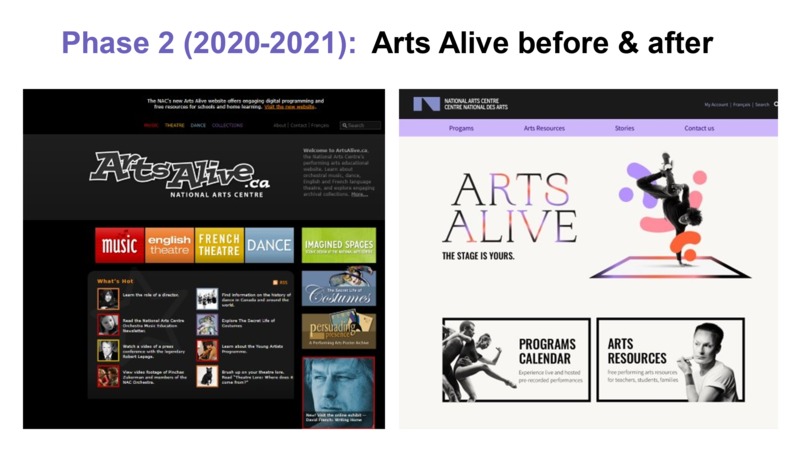A New Cross-Disciplinary Team Leads the Charge Through Online Shift
The move to online platforms was not new for the Music Education Department. Under the leadership of Pinchas Zukerman and Peter Herrndorf in the early 2000s, the NAC developed their own technological infrastructure for remote and distance learning. In Art and Politics: The History of the National Arts Centre, Sarah Jennings explores this development of artist training programs and educational tools. Zukerman and Herrndorf joined forces in 1999 to create an online platform that would expand the NAC’s music education initiative, both nationally and internationally. Herrndorf had a desire to make the NAC a truly national organization; as NAC's Archivist-Curator Robert VanderBerg relayed, digital efforts played a critical role in putting these goals in action. At the same time, Zukerman believed in wide-reaching accessible music education. Their collaborative efforts resulted in the creation of the Arts Alive platform in 2001, a virtual space dedicated to arts education resources for the public. What is critical to understand about Arts Alive is its innovation: before YouTube, Spotify, and iTunes existed, the NAC had developed a free online education and streaming portal, making music widely accessible via their website just a few years ahead of the digital service provider revolution. Having gained significant traction in Canada, the United States, and Europe (with over 5,000 hits a day), Arts Alive provided resources for teachers, parents, students, and adult learners alike. Arts Alive, as VanderBerg indicated, has been an invaluable resource to the NAC staff, especially for archival material, documentation of costumes, and original NACO recordings (Music Box).
Having established an online presence through Arts Alive, the NAC was able to expand their virtual programming, in an effort to reach a wider audience, with the launch of their MusicAlive program in 2006. Bringing music education to remote and Northern communities both through in-person activities and virtual programming, MusicAlive allowed the NAC to collaborate with more than 100 Indigenous teaching artists every year. Both of these programs have evolved over the years and continue to grow. After a soft launch in May 2021, the NAC officially launched their new Arts Alive platform in August 2021, which has distinct modules geared toward different user groups—from schools, to families, to adult learners, and more.
During the early days of the pandemic in 2020, this investment in digital and national engagement served the NAC well. The original designers of Arts Alive remain a core part of the NAC’s digital design team. This was particularly advantageous as the NAC moved to online platforms in March 2020. The NAC’s Digital Engagement team used its considerable technological skills acquired over the years to support NAC programming to pivot online and create a new user-centric arts learning platform. They were able to expand their existing resources to meet the needs of a variety of audiences, which included students, parents, educators, adults, and artists. Harnessing the potential of distance learning technology, the Music Education Department moved their programming online and worked in collaboration with other disciplinary departments at the NAC (English Theatre, French Theatre, Indigenous Theatre, Public Spaces Programming and Dance) to offer a series of virtual workshops with culturally diverse artists. The original Arts Alive platform (just recently taken offline) stands as a great example of the NAC’s digital strength, evolution, their initiatives, values, and skill set at a time when no other organization in Canada was offering distance learning and streaming. As VanderBerg expressed: “the value and appreciation for online programming and resources, such as Arts Alive, was renewed by both staff and patrons over the course of the COVID-19 pandemic when arts organizations had no way of bringing people through the door.”
In addition, with the announcement of NAC’s 2020-2023 strategic plan, the organization made a commitment to address Inclusion, Diversity, Equity, and Accessibility (IDEA). Moving forward, the Music Education Department and other NAC departments hope to continue building partnerships with more equity-seeking arts organizations and community programs.
Senior Director of Learning and Community Engagement, Geneviève Cimon sat down with us, via Zoom in November 2020, to discuss the ways in which she and her team pivoted during the early days of the pandemic. She communicated to us that although difficult, she and her team believed the pandemic provided the opportunity for “re-evaluation, renewal, new paradigms, leadership, and partnership”. Describing her role as “a producer, facilitator, and convener,” Cimon works alongside other arts education organizations to create meaningful programs and projects. In addition to overseeing a cross-departmental team working on the new Arts Alive platform, she leads the Music Education team in regard to budgeting, programming, partnerships, and community engagement to offer quality and accessible music education programs to Canadians across the country. Their programs also aim to achieve other goals such as “supporting artists in their training, offering accessible arts programs in rural and remote communities with local partners, and creating free resource materials for schools and teachers,” just to name a few key initiatives.
At the beginning of the pandemic, the Music Education Department offered artist training programs through collaborations with other professional orchestras across the country. After meeting with arts consultants, her team developed virtual workshops and concerts for schools, teachers, and parents. This involved extensive collaborations with partners such as Jeunesses Musicales Canada, MusicFest Canada, the Sphinx Organization, the Coalition for Music Education, and Orchestra of the Americas.
One of the main challenges for this new multi-disciplinary initiative was curating a dynamic offering of culturally diverse and relevant offerings, to local, national, and international audiences. As Cimon said, “necessity is the mother of invention,” and in those early days of the pandemic, she and her team developed a broad range of varied programs featuring culturally diverse teaching artists from across the country. This new mode of virtual learning, for schools and families, was achieved through cross-departmental and cross-organizational work at the NAC – a new endeavor for all staff. Disciplines across the organization had the opportunity to align on policies and programs, and to create new work-flow processes.
The Music Education Department launched new modules in Spring 2021 that are catered not only to teachers and artists, but to families, and music enthusiasts who are keen to learn more about the arts. This includes the launch of Arts Alive. “The pandemic brought all the disciplines together,” Cimon relayed to us, “enabling us to tear down the silos that divide us and conceive of a multidisciplinary platform that is more user-friendly.” This is evident on the new Arts Alive site, which is an outstanding resource for the arts community in Ottawa and across the country. They are using an agile management framework to remain nimble, responsive, and relevant, to learn and adapt, and to respond to the needs of their audiences. The Music Education Department hopes that the opportunities to build innovative partnerships within the NAC as well as with external partners during the pandemic will carry on long after the crisis is over.
A pre-recorded virtual performance conducted by Alexander Shelley and performed by the Denis Wick Canadian Wind Orchestra and the Thomastik-Infeld Canadian String Orchestra as part of MusicFest 2020.
[Audio Description: Alexander Gibson’s Prelude Allegretto, the first of the three movements starts at a leisurely walking pace. Melodic woodwinds accompanied harmonically by the soft expansive sound of the brass instruments, transition into a march-like tempo with percussion. The section ends in a climactic outburst of sound and emotion, before transiting into a movement featuring all stringed instruments. The tempo has picked up and the rich emotive melodies alternate with light pizzicato musical gestures. The third movement is in a quick dance-like style that sounds light and bright.]


